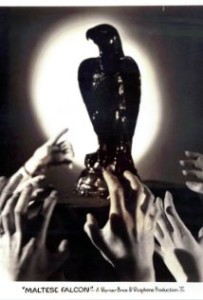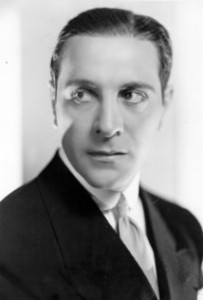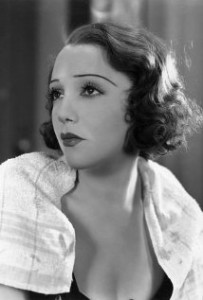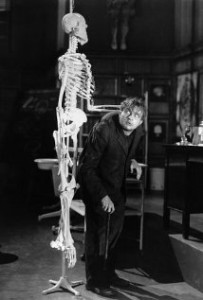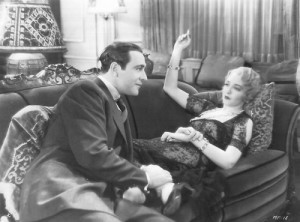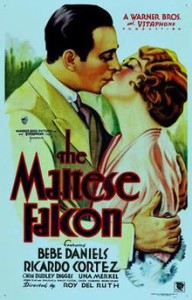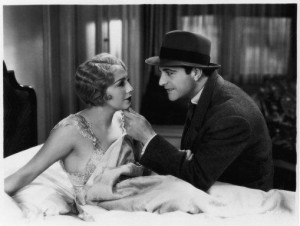The Maltese Falcon **** (1931, Bebe Daniels, Ricardo Cortez, Dudley Digges, Thelma Todd, Dwight Frye) – Classic Movie Review 2,465
Warner Bros’ 1931 thriller The Maltese Falcon is the first film of Dashiell Hammett’s famous crime novel. Ricardo Cortez stars as the wisecracking, cynical San Francisco gumshoe Sam Spade, who sets off on the trail of the ancient Maltese Falcon statuette.
Director Roy Del Ruth’s 1931 Warner Bros thriller The Maltese Falcon is the first film of Dashiell Hammett’s famous 1930 hardboiled crime novel. Ricardo Cortez stars as the wisecracking, cynical San Francisco gumshoe Sam Spade, who sets off down the city’s mean streets on the trail of the ancient Maltese Falcon statuette, a priceless 16th-century missing black art object, now apparently missing and worth killing and dying for.
Grippingly and often excitingly done, this movie, old as it is, would be much more famous if there wasn’t an even better version. It certainly deserves to be.
Silent movie star Cortez is very impressive in a smooth star performance as much less of a rough diamond as the womanising Spade than Humphrey Bogart, who made the role his own in John Huston’s 1941 remake The Maltese Falcon. Cortez makes Spade as just as flirtatious and dangerous as his female counterpart, Ruth Wonderly (Bebe Daniels), who hires Spade and his detective partner Miles Archer (Walter Long) to follow Floyd Thursby, a man who she says ran off with her younger sister.
Bebe Daniels make a very effective and exciting treacherous femme fatale, Spade’s new client who, at least at first, goes by the name of Miss Ruth Wonderly, while Dudley Digges is a creepy, slimy, sweaty villain Casper Gutman, a very successful performance, and Danish actor Otto Matieson is another success as the fey, sinister Dr Joel Cairo.
Director Roy Del Ruth achieves a tense and suspenseful atmosphere of melodramatic menace, and rattles the story along at a grand lick in a short running time of 82 minutes. The screenplay by Maude Fulton, Lucien Hubbard (uncredited) and Brown Holmes is satisfyingly faithful to Hammett and laced with some well-done dark humour, and much of the dialogue taken verbatim directly from the novel, the same as in the 1941 film. In some ways, the plotting and characters are clearer than in the 1940 film, but that is partly because of its pre-Code freedom, though also because of its cracking screenplay.
There’s a particularly good scene where Spade lifts Wonderly’s latchkey while she sleeps in his bed, and set off to ransack her apartment systematically, finding nothing, and surreptitiously replacing the latchkey. [Spoiler alert] The ending is cute too. Spade goes to visit Wonderly in prison and instructs the matron to treat her well and give her whatever she wants, paid for by the district attorney’s office where he has been made chief investigator. All satisfying and quite different from the 1941 film.
Also in the cast are Thelma Todd as Iva Archer, Dwight Frye as the thuggish young gunman Wilmer Cook, Robert Elliott as police Detective Lieutenant Dundy, Una Merkel as Spade’s secretary Effie Perine, Walter Long as Spade’s detective partner Miles Archer, J Farrell MacDonald as police Detective Sergeant Tom Polhaus, along with Agostino Borgato (as ship’s Captain John Jacobi), Cliff Saum, Morgan Wallace (the District Attorney), Lucille Ward and Tiny Jones.
The Maltese Falcon is frank for its day. Daniels is shown bathing and is strip-searched by Spade. For better or worse, Hammett’s stuff is on screen: Wilmer is called Gutman’s ‘boyfriend’, Effie describes Cairo to Spade as ‘gorgeous’ and Spade taunts Dundy by referring to him as ‘sweetheart’, ‘darling’ and ‘precious’.
An American DVD of The Maltese Falcon is available in a double bill with Satan Met a Lady, and The Maltese Falcon plays on Turner Classic Movies, who restored the original title after it was changed for TV to Dangerous Female to avoid confusion with the 1941 The Maltese Falcon.
Robert M Haas was art director both on this and the 1941 The Maltese Falcon.
A portrait of Louise Brooks hangs in Spade’s apartment above his telephone.
When Warner Bros tried to re-release the film in 1936, the Production Code Office was censoring movies and it refused approval due to the film’s supposedly ‘lewd’ content. So Warners produced a new version, Satan Met a Lady, starring Bette Davis in 1936, but the story was changed and the film was given a comedy tone. Unedited versions of the 1931 film could not be shown in the United States for many years, that is until the end of the Motion Picture Production Code in the mid-1960s. An edited version ran at 75 minutes.
Red Harvest (filmed in 1930 as Roadhouse Nights) and City Streets (1931), based on a short story and starring Gary Cooper and Sylvia Sidney, preceded this as Hammett movie adaptations.
© Derek Winnert 2015 Classic Movie Review 2,465
Check out more reviews on http://derekwinnert.com

